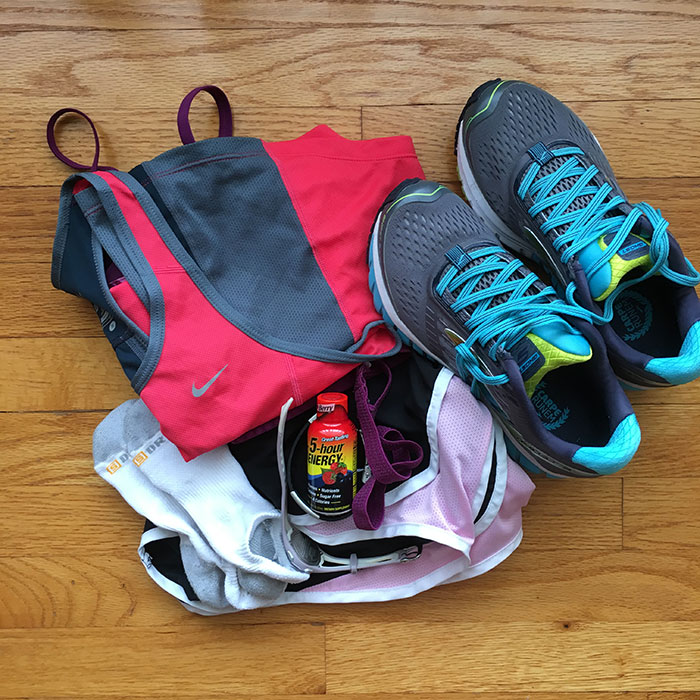When I first started running regularly I used to frequently get a painful pinch on the side part of my torso, around my mid-section, below my rib cage. These are called running cramps and are actually quite common among new runners. Even experienced runners can still have them sometimes.
The pinching feeling quickly brought me back to high school gym class and the pinch I would feel in my diaphragm after being prompted to run a one-mile speed test for statewide fitness tests. Back then I was not a runner (correction not a runner at all!).
I couldn’t imagine why anyone would willingly run, let alone run for fun, and experience these stomach cramps. When I started running for fitness years later I experience this cramping sensation again and wanted to get to the bottom of what was causing it and how to prevent it. Today I’ll share what I learned.
Running Cramps
What Are They?
These side pains, or side cramps, I now know, are more commonly known as side stitches, runner’s cramps or side stitches. They are common when running and while they can happen to even the most seasoned and experienced runner.
They do happen less frequently to me now that I know what running side cramps are and how to prevent them. There are many causes for them, I will explain the common causes and then share tips to prevent cramps or stop them once you have them during a run.
What Causes Them?
There are many theories about what causes cramps while running, and the cramping can vary depending on the person and the location of the cramps.
According to a report by Women’s Health, “When running, the legs put pressure on the diaphragm from below, while super-fast breathing puts pressure on the diaphragm from above, effectively pinching the muscle and cutting off the flow of blood and oxygen to the muscle.”
That sounds super medical and complicated right? Another theory is more simple, running causes ligaments attached to internal organs to be tugged around, causing the discomfort.
Cramping that is lower in the abdomen could be coming from the stomach and be spurred by something you ate or drank before your run.
Related blog posts:
• Fun Running Clothes Running Attire Tips
• 8K Training Plan Using Hal Higdon 8K
• Weak Butt Causes, Symptoms and Treatment
• 10-Miler Training Plan for Runners
No matter the cause of the side cramps, most everyone will agree they are painful to experience and make you want to stop your run dead in its tracks. But there is hope for cramping while running.
You don’t have to push through side stitches during every run. And if you do get a side stitch during your run, there are a few tactics you can follow to minimize the discomfort and, possibly, make it go away completely.
How Do You Prevent Them?
Here are some common ways to stop or prevent cramps from starting. Some of these methods are condoned by experts and some are from my own personal experience as a runner over the last seven years.
I hope these tactics will help eliminate side stitches during your next run. I will share multiple tactics, if one method does not work, try another. Over time I have found what works best for myself, but this may vary depending on your personal running experience.
Running Cramps in Side
How to Prevent
• Control Your Breathing: Personally I have found that if I breathe in my nose and out my mouth during my run, I am less likely to experience this uncomfortable condition. When I would get carried away and breathe in and out my mouth it seemed to make the cramping occur. Experts call this lower lung breathing.
• Be Mindful of Diet: Many experts believe the fitness cramps are spurred by what you eat before going for a run. “Foods that are higher in fat and fiber take longer to digest.
That doesn’t mean they are bad foods, but if you eat them within one to two hours before a run, they can cause havoc — creating stomach upset, stitches, and other problems,” according to a Runner’s World report.
• Practice Proper Hydration: Similarly, drinking too much or too little before a run can increase your risk of developing side stitches while running. In addition to drinking water, there are a variety of hydration drinks for runners.
A few I have tried include ZICO Coconut Water, Accelerade, GU Roctane and Nuun. Instead of chugging water before your run, you might also bring a small bottle of water with you to sip from during your run. I really like the FuelBelt Spring Palm Water Holder.
Today there are even more hydration options available. Some other popular electrolyte brands also include Liquid IV, Redmont ReLyte and LMNT. I’ll share these in a list in case you want to try them all and determine which is your favorite!
Electrolyte Supplement Options
• ZICO Coconut Water (this link includes a full product review)
• Accelerade (this link includes a full product review)
• GU Roctane (this link includes a full product review)
• Nuun
• Liquid IV
• Redmont ReLyte
• LMNT
When comparing these electrolyte and hydration drinks there are a few considerations. Some are salt-based only so they do not taste sweet. Some runners may prefer this or think it’s terrible. The salt-based options have become increasingly popular over the last few years.
Others have sugar in them so they taste more like a traditional Gatorade or Powerade drink. Some also advertise low-sugar or are sweetened with Stevia for a more “natural” sweetness. Most of the powder products can be purchased in a bulk serving container where you measure out your individual serving at home.
Alternately, some are sold in individual packets which can be helpful especially for travel or on-the-go. ZICO or any brand of coconut water comes similar to a traditional sports drink – in liquid form ready to drink. Lastly, products such as Nuun are not a powder but a tablet that is added to water to create the drink.
Any hydration supplement is intended to be just that. A supplement, similar to a multivitamin. Naturally our bodies make electrolytes via the food you eat and beverages you drink. But when running, working outdoors in the heat or exercising heavily the body can lose these electrolytes more quickly via sweat.
Now for some additional tips, continue reading…
• Don’t Forget a Warmup: Like my high school story, where I had to run fast and furious for one mile with little to no warmup, experts say the lack of a warmup prior to your run can prime your body for developing side cramps.
A sample warmup may be to “Invest in two to three minutes of brisk walking, gradually work into an easy running effort, and then into your planned running workout pace,” according to Runner’s World.
• Slow Down Your Pace: When you first begin running you want to go fast and far, but building up running endurance is a slow process. Tone back the excitement just a little bit and slow your pace and those running cramps in stomach may go away.
• Strengthen the Abdominal Wall: Abdominal exercises, such as planks, can help strengthen the area prone to cramping. Core strength is vital to successful running, so this is a good practice regardless of whether or not you get cramps during your run.
Cramps from Running
In Summary
I hope this post was helpful for cramping while running and in understanding what side cramps while running are and how they can be prevented. While cramps while running are annoying, I can attest that I experience them less the longer I have been running.
Over the years I have learned how to strengthen my core, hydrate and fuel properly and generally avoid a lot of the common causes of side cramps from running.
What are your tips for preventing side cramps?
Sources: WebMd.com, Runner’s World, Women’s Health





I focus on taking really deep breaths when I get them and making sure that I am drinking enough water, and not too much water before/during my runs 😀
Haha! The funny thing is now that you mention that I recall doing that when I "ran" track in junior high school. There must be some truth to it!
I don't get them but I've heard you're supposed to keep running and hold your arms up. Seriously. My friend swears by this… and also looks like a lunatic but eventually she runs through it and is ok again.